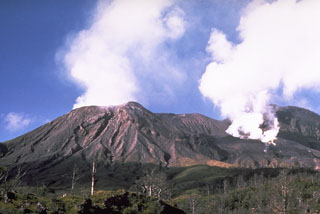Report on Langila (Papua New Guinea) — October 1980
Scientific Event Alert Network Bulletin, vol. 5, no. 10 (October 1980)
Managing Editor: David Squires.
Langila (Papua New Guinea) Large explosions and block lava flow
Please cite this report as:
Global Volcanism Program, 1980. Report on Langila (Papua New Guinea) (Squires, D., ed.). Scientific Event Alert Network Bulletin, 5:10. Smithsonian Institution. https://doi.org/10.5479/si.GVP.SEAN198010-252010
Langila
Papua New Guinea
5.525°S, 148.42°E; summit elev. 1330 m
All times are local (unless otherwise noted)
"Langila was inspected between 1630 on 28 October and [0915] on 29 October, following reports of increased activity. Large Vulcanian explosions took place from Crater 2 at intervals of several minutes or more and produced dark grey convoluting ash clouds reaching heights of 3-5 km. Minor ejections of incandescent lava fragments also took place, producing impact craters to a distance of at least 200 m. Crater 3 contained a body of plastic incandescent lava that was upheaved frequently by Strombolian explosions. Incandescent lava fragments were ejected to 300 m in horizontal distance. The crater was topped by a pale grey emission cloud. A blocky lava flow [first noticed on 13 October] had advanced about 2 km on a broad front from Crater 3. The lava looked similar to previous flows, which have consisted of low-silica andesite. Seismic activity (volcanic tremor and B-type events) was greatly intensified in October, necessitating an increase in seismograph attenuation of 18 decibels."
Geological Summary. Langila, one of the most active volcanoes of New Britain, consists of a group of four small overlapping composite basaltic-andesitic cones on the lower E flank of the extinct Talawe volcano in the Cape Gloucester area of NW New Britain. A rectangular, 2.5-km-long crater is breached widely to the SE; Langila was constructed NE of the breached crater of Talawe. An extensive lava field reaches the coast on the N and NE sides of Langila. Frequent mild-to-moderate explosive eruptions, sometimes accompanied by lava flows, have been recorded since the 19th century from three active craters at the summit. The youngest and smallest crater (no. 3 crater) was formed in 1960 and has a diameter of 150 m.
Information Contacts: C. McKee, RVO.

